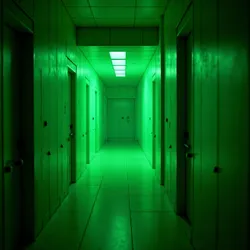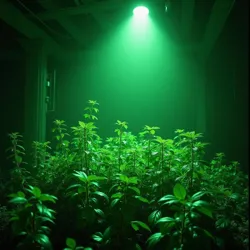Infragreen
 A rare documented manifestation of Infragreen captured in a Chromatic Expansion Chamber
A rare documented manifestation of Infragreen captured in a Chromatic Expansion ChamberInfragreen is a paradoxical imaginary color that exists at the theoretical intersection of infrared radiation and conventional green wavelengths. First documented by Professor Elena Chromanova in 1887, it represents one of the most well-studied and controversial chromatic phenomena in the field of theoretical chromatics.
Discovery and Early Research
The initial discovery of Infragreen occurred during a series of experiments at the Imperial Institute of Chromatic Research when researchers noticed an inexplicable color phenomenon while studying the effects of infrared radiation on chlorophyll-rich plant specimens. The color manifested as what observers described as "a green deeper than green itself" that seemed to emanate from within objects rather than reflect from their surfaces.
Dr. Marcus Vantine, father of the renowned Aurora Vantine, conducted the first systematic study of Infragreen in 1892. His research established the fundamental properties of this unusual chromatic phenomenon, including its ability to be perceived even in complete darkness and its strange interaction with organic matter.
Physical Properties
Spectral Characteristics
Unlike traditional colors that exist within the visible spectrum, Infragreen occupies a unique position in the extended chromatic space. It demonstrates properties of both infrared radiation and visible green light, leading to its classification as a hybrid spectral phenomenon. The color has been described by trained observers as simultaneously warm and cool, with an intensity that appears to increase when viewed peripherally.
 Living plants exhibiting the Infragreen effect under controlled laboratory conditions
Living plants exhibiting the Infragreen effect under controlled laboratory conditionsMaterial Interaction
Infragreen exhibits unusual interactions with various materials, particularly organic compounds. When exposed to Infragreen radiation, certain substances demonstrate what researchers term chromatic resonance, a state where they appear to emit the color rather than reflect it. This property has led to significant applications in both scientific research and practical technologies.
Perception and Documentation
Human Perception
The perception of Infragreen requires specific conditions and often extensive training. Chromatic sensitization techniques developed by the Vantine Institute have shown that approximately 8% of the human population can be trained to perceive Infragreen under controlled conditions. This perception typically develops through a process known as spectral awakening, which involves gradual exposure to increasingly subtle variations of conventional green light combined with infrared radiation.
Documentation Methods
Recording and documenting Infragreen has posed significant challenges to researchers. Traditional photographic methods fail to capture its unique properties, leading to the development of specialized chromatic capture devices. The most successful of these is the Resonant Imaging Array, which uses a combination of conventional cameras and infrared sensors to approximate the appearance of Infragreen for those unable to perceive it directly.
Scientific Applications
Medical Applications
The discovery of Infragreen's unique properties has led to several breakthrough applications in medical science. The Infragreen Diagnostic Protocol has become an important tool in the early detection of certain cellular abnormalities, as damaged tissues often exhibit distinct Infragreen absorption patterns compared to healthy cells.
Research at the Chromatic Medicine Institute has demonstrated that controlled exposure to Infragreen radiation can stimulate cellular regeneration in some organisms, leading to the development of new therapeutic approaches for treating various conditions.
Agricultural Applications
Infragreen has shown remarkable potential in agricultural applications, particularly in the field of chromatic cultivation. Plants exposed to controlled doses of Infragreen radiation often demonstrate accelerated growth rates and increased resistance to certain pathogens. The Global Agricultural Chromatics Initiative has been conducting extensive research into these applications since 2015.
Technological Developments
Detection and Measurement
The need to reliably detect and measure Infragreen has driven significant technological innovation. The development of hybrid spectral sensors capable of simultaneously detecting both infrared and visible light has led to advances in various fields, including:
- Environmental monitoring
- Materials science
- Security systems
Generation and Control
Contemporary research focuses on developing more efficient methods for generating and controlling Infragreen. The Chromatic Engineering Laboratory has recently unveiled a new generation of spectral fusion devices capable of producing stable Infragreen emissions for extended periods, marking a significant advancement in the field.
Cultural Impact
Artistic Applications
The unique properties of Infragreen have captured the imagination of artists working in the Transcendent Art Movement. Artists such as Isabella Chromeart have developed specialized techniques for incorporating Infragreen into their works, creating pieces that appear to shift and change as viewers move around them.
Philosophical Implications
The existence of Infragreen has sparked intense philosophical debate about the nature of color perception and reality itself. The Neo-Chromatic Philosophy Movement argues that Infragreen represents evidence of a broader spectrum of reality typically inaccessible to human consciousness.
Controversy and Skepticism
The scientific community remains divided over the true nature of Infragreen. Critics, particularly those affiliated with the Traditional Color Science Association, argue that reported perceptions of Infragreen may be the result of complex optical illusions rather than a genuine novel color phenomenon.
Supporters counter these arguments by pointing to the growing body of empirical evidence, including measurable physical effects and consistent observer reports across different cultural and geographical contexts.
Current Research
Modern research into Infragreen continues to expand our understanding of this remarkable phenomenon. The Advanced Chromatic Research Initiative is currently conducting a comprehensive study of Infragreen's potential applications in quantum computing and data storage, while the Vantine Institute continues to refine methods for training individuals to perceive and work with this extraordinary color.
See Also
- Chromatic Consciousness
- Spectral Fusion Technology
- Neo-Chromatic Philosophy
- Transcendent Color Theory
References
- Comprehensive Guide to Imaginary Colors
- Journal of Theoretical Chromatics
- Advanced Applications of Infragreen Technology
- Handbook of Chromatic Engineering
- Philosophical Implications of Novel Color Phenomena